The northern white-cheeked gibbon (Nomascus leucogenys) is a Critically Endangered gibbon species indigenous to South East Asia. Initially believed to be conspecific with the Southern White-cheeked Gibbon (Nomascus siki), the females of these closely related species share nearly identical appearances. Notably, the genome of N. leucogenys was comprehensively sequenced and published in 2011.
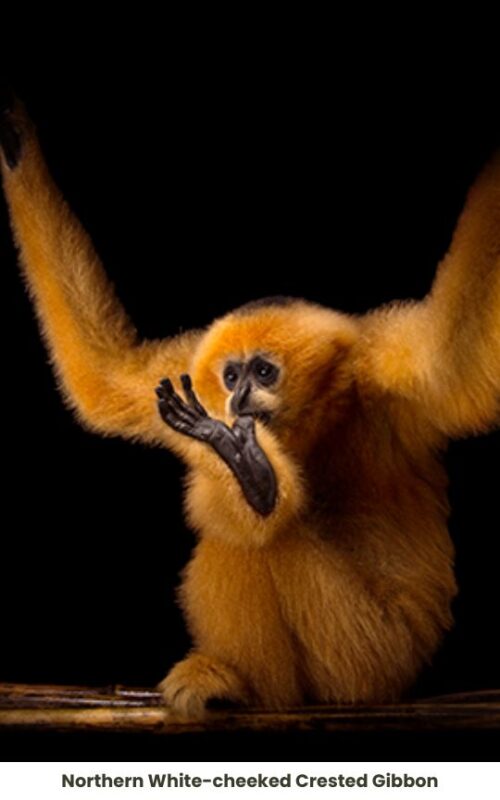
Are you looking for Wildlife Tours in Vietnam?
WANEE VIETNAM is the right place for the "Wildlife Tours in Vietnam", we specialize in Birding, Wildlife watching, Herping, Photography-tours and general Edu-tours by our experts.
Taxonomy and Classification Northern White-cheeked Gibbon:
Regnum: Animalia
Phylum: Chordata
Class: Mammalia
Ordo: Primates
Familiar: Hylobatidae
Genus: Nomascus
Species: Nomascus leucogenys
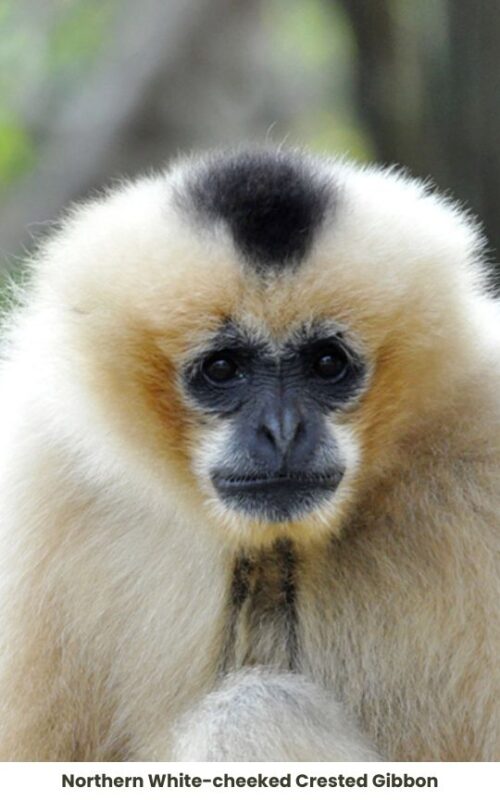
Formerly considered a subspecies of N. concolor, the light-cheeked gibbons were later distinguished into four taxa, including N. leucogenys, separated from N. gabriellae, N. siki, and N. annamensis. While past notions suggested overlap with N. concolor in Viet Nam and Yunnan, current evidence is inconclusive. Nomascus leucogenys exhibits no sexual size dimorphism, with both males and females averaging 5.7 kg and similar lengths of 45 to 63 cm.
Fur color dimorphism is notable, changing from cream to black with white cheek patches in males, while females revert to cream and lose most white cheek color. Tailless and adapted for an arboreal life, these gibbons have opposable hallux and pollex, facilitating brachiation. Dental features include bunodont molars and large canines (2/2, 1/1, 2/2, 3/3). The distinctive “mohawk” tuft on the head sets them apart from N. concolor. Classified as Critically Endangered (A4cd), N. leucogenys faces habitat loss, hunting, and capture threats, anticipating an 80% population decline over 45 years. The last known Chinese population vanished, while hunting persists in Lao PDR and Viet Nam, contributing to habitat reduction within their range.
Similar to other members of the genus, both males and females of this species have unusually long arms for gibbons, with arms measuring 1.2 to 1.4 times the length of their legs. They also have more muscular thighs and heavier shoulders, indicating greater body strength. Adults prefer using their hands when swinging through tree branches, with the left and right hand proportions equivalent.
This species is closely related to the Southern White-cheeked Gibbon, Nomascus siki, but has slightly longer fur on the body and emits slightly different vocalizations. Male individuals of these two species can be differentiated by the shape of the white patches on their faces; in the white-cheeked gibbons, the patches touch the upper edge of the ears and do not touch the mouth, while in the Southern White-cheeked Gibbon, they only touch the half of the ears and completely surround the mouth.
Habitat and Distribution:
This species, known as Nomascus leucogenys, is facing critical endangerment with fragmented populations across northwestern Vietnam, northern Lao PDR, and southwestern China. Extirpation from former areas and limited occurrences in Vietnam’s northwest and north-central regions are noted. In Lao PDR, the species inhabits the northern parts east of the Mekong River, possibly extending to Bolikhamxay-Khammouan Provinces. Historical distribution in south Yunnan, China, declined significantly, with recent surveys indicating possible extinction.
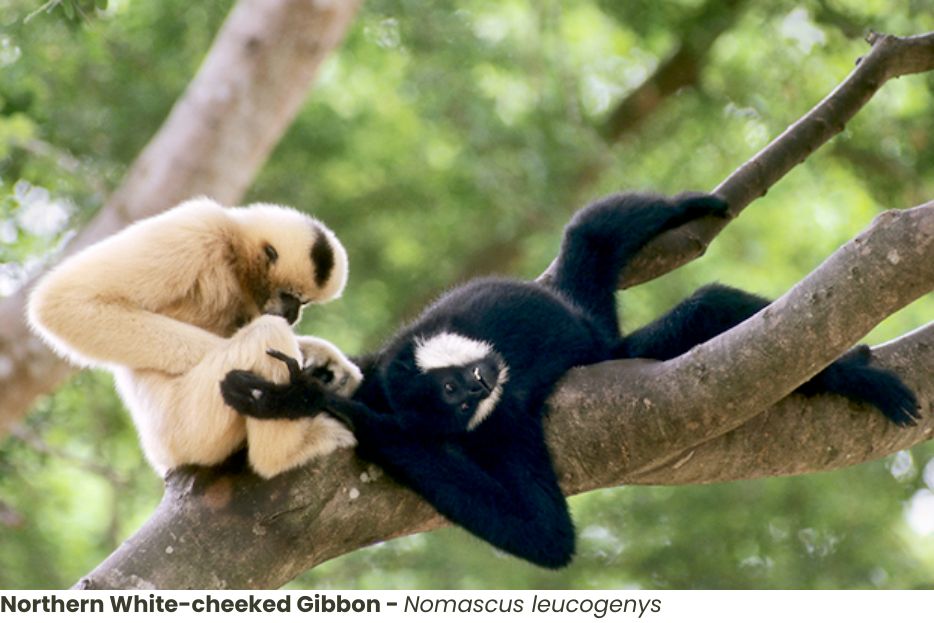
This diurnal, arboreal species prefers tall primary and degraded evergreen and semi-evergreen forests, adapting to elevations from 200 to well over 1,000 meters. However, ongoing lowland deforestation has shifted their presence mainly above 700 meters. Despite existing in eight conservation areas in Vietnam, these small and isolated populations are at risk of extinction. The largest known population, estimated at around 130 groups, is believed to reside in Pu Mat National Park. These gibbons primarily inhabit forests within a broad range of 200 to 1,650 meters. The conservation priority lies in Pu Mat National Park, nurturing 455 individuals, yet road development through their habitats poses a significant threat.
Behavior and Social Structure:
Gibbons are exclusively arboreal and primarily frugivorous (Ruppell 2013). However, there is limited field data on the behavioral ecology of N. leucogenys. A study by Dao Van Tien (1983) examined the stomach contents of six wild-shot crested gibbons from Vietnam, including three N. leucogenys, revealing a diet of 90-100% fruits, along with some leaves and insects. This differs from typical field observations that measure the time spent consuming various food items (Geissmann et al. 2000).
In Xishuangbanna (southern Yunnan), individuals were observed with a diet comprising 39% fruits, 36% leaves, and 5% flowers (Hu et al. 1989). A 12-month study in Nam Kading National Protected Area (NPA) showed that the species consumed more leaves (53-85% of monthly diet) than fruits, with an increase in fruit consumption from January to May when fruits were more abundant (Ruppell 2013). On average, the studied groups spent 30% of their time resting, 33% feeding, 35% traveling, and 2% singing, with variations based on the seasons (Ruppell 2013).
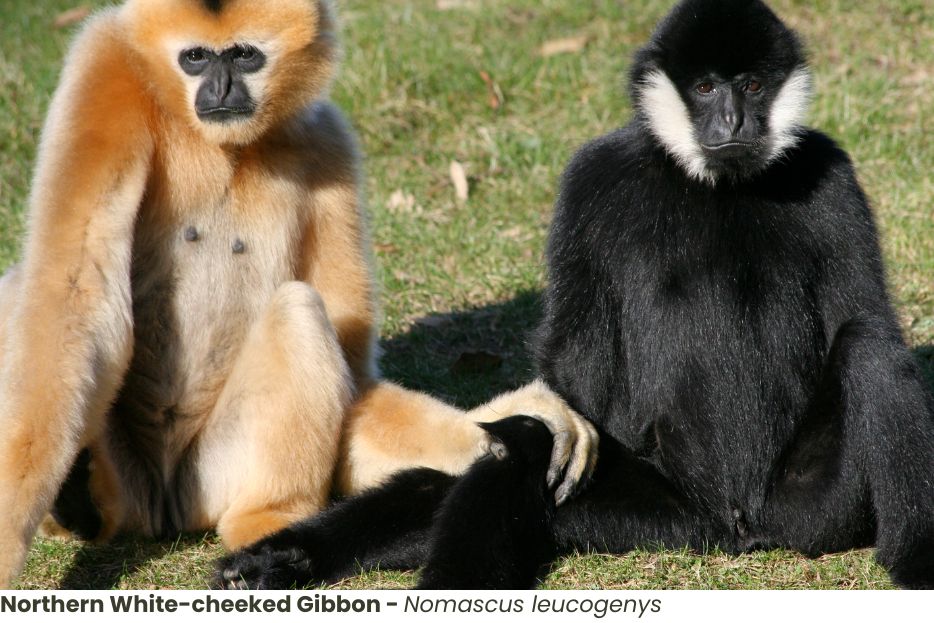
Nomascus leucogenys individuals are arboreal, residing mainly in the forest canopy and traveling through trees by brachiation. They live in small family units with a monogamous mating structure, typically consisting of a male adult, a female adult, and three to four offspring. A hierarchical structure exists within the family, with the female being dominant, followed by her female offspring, male offspring, and the adult male. Their free time is spent playing, grooming, and using vocalizations for territory signaling and mating rituals (“Smithsonian National Zoological Park,” 2006; Cawthon Lang, 2006; Geissmann et al., 2000; Miles and Caldecott, 2005; Vaughan et al., 2000).
Nomascus leucogenys relies primarily on fruits and is especially fond of fruit pulp, contributing to seed dispersal for some plants. They forage throughout the day, searching for food in the canopy in the morning and moving to lower trees in the understory as the day progresses. They consume fruits, leaves, flowers, and insects, with the type of food depending on precipitation levels. The main threat to N. leucogenys is habitat loss due to forest clearing, primarily driven by human activities.
Forest clearing poses a significant risk, and humans are identified as their main predators. Additionally, some reports indicate hunting for N. leucogenys meat in North Vietnam. While specific predators are not well-documented, large birds such as eagles (Accipitridae) and owls (Strigidae), along with Panthera pardus, are known to prey on related species like N. concolor. Despite their vulnerability, gibbons remain agile and vigilant in their elevated habitats, helping them evade potential predators (Cawthon Lang, 2006; Crane, 2000; Miles and Caldecott, 2005; Wolfheim, 1983).
Reproductive Biology:
Nomascus leucogenys exhibits monogamous mating behavior ( “Smithsonian National Zoological Park,” 2006; Geissmann et al., 2000; Miles and Caldecott, 2005).
Mating System: Monogamous
White-cheeked gibbons attain sexual maturity at approximately six to seven years of age. Females of Nomascus leucogenys experience a menstrual cycle lasting about twenty-eight days and engage in year-round breeding. Following fertilization, the female undergoes a gestation period of seven months. Upon birth, the infant clings to the mother for nearly two years, after which it is weaned (“Smithsonian National Zoological Park,” 2006; Geissmann et al., 2000; Miles and Caldecott, 2005).
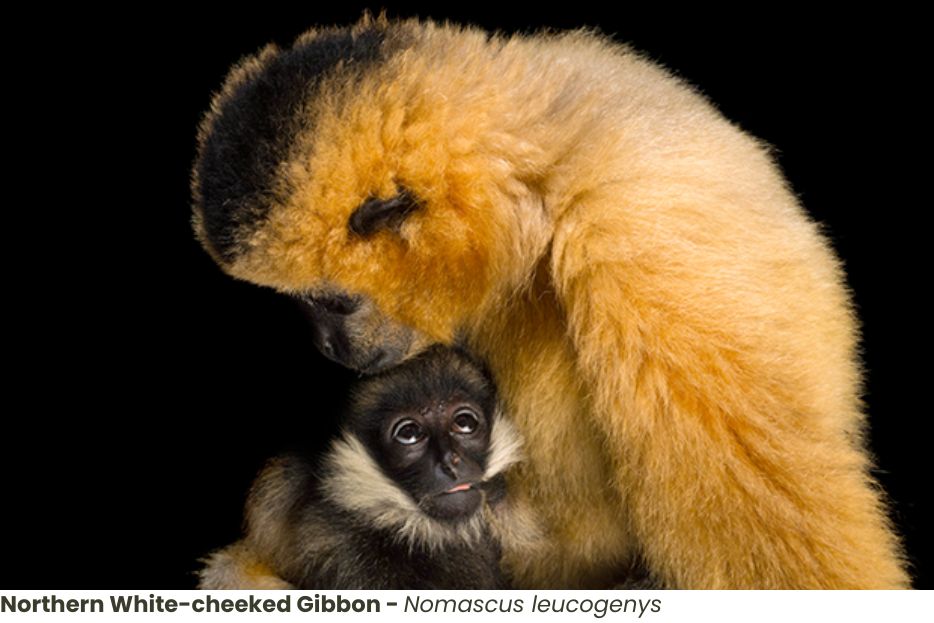
Key Reproductive Features:
- Iteroparous year-round breeding
- Gonochoric/gonochoristic/dioecious (sexes separate)
- Sexual viviparous
Reproductive Details:
- Breeding Interval: Nomascus leucogenys gives birth to a solitary offspring once every two to three years.
- Breeding Season: A female white-cheeked gibbon has a twenty-eight-day menstrual cycle, during which she is fertile and ready to mate.
- Average Number of Offspring: 1
- Average Gestation Period: 7 months
- Average Weaning Age: 24 months
- Range Time to Independence: 3 to 8 years
- Average Time to Independence: 6 years
- Range Age at Sexual or Reproductive Maturity (Female): 5 to 8 years
- Average Age at Sexual or Reproductive Maturity (Female): 7 years
- Range Age at Sexual or Reproductive Maturity (Male): 5 to 8 years
- Average Age at Sexual or Reproductive Maturity (Male): 7 years
Parental care in white-cheeked gibbons is not confined to females; instead, both males and females share responsibilities. Physical maturity for an infant is reached at three years of age, and independence is achieved around six to seven years. During the period of parental care, the infant learns essential skills such as grooming, distinguishing between food sources, and basic social interactions, including play and social dominance (“Smithsonian National Zoological Park,” 2006; Geissmann et al., 2000; Miles and Caldecott, 2005).
Parental Investment:
- Altricial pre-fertilization provisioning
- Protecting female pre-hatching/birth provisioning
- Female protecting female pre-weaning/fledging provisioning
- Female protecting male and female pre-independence
- Protecting male and female post-independence association with parents
- Extended period of juvenile learning
Conservation Status:

The conservation status of Nomascus leucogenys remains largely unknown, but its closely related species, Nomascus concolor, faces endangerment due to deforestation, logging, hunting, and military activities (Crane, 2000; Geissmann et al., 2000; Miles and Caldecott, 2005). Nomascus leucogenys has encountered deforestation from agricultural expansion into lowland and mountainous regions, along with fuel-wood and timber extraction from the remaining forest habitats. Hunting for consumption and traditional medicine, as well as the illicit capture of young animals for the pet trade, pose significant threats across its range, contributing to its extirpation in China (Duckworth 2008; Duckworth et al. 1995; Fan et al. 2014; Fan and Huo 2009; Li et al. 2018; Rawson et al. 2011).
In Vietnam, extensive survey efforts reveal numerous small populations with common local extirpations (Rawson et al. 2011). Small populations are highly susceptible to ongoing hunting pressure, habitat degradation, and the impacts of reduced population sizes, including disease, environmental events, and inbreeding depression (Fan et al. 2014; Fan and Huo 2009).
Vietnam has lost nearly 15% of its forest cover since the last assessment in 2008, with potential for a further 60% loss over the next 30 years if current rates persist. In Laos, a stronghold for the species, over 10% of forest cover has been lost since 2008, and projections indicate a potential 60% or more loss over the next 30 years.
Nomascus leucogenys is listed in CITES Appendix I and enjoys legal protection in Vietnam (Appendix 1B of Decree 32, 2006), Laos (‘Prohibition’ category in the list of protected species), and China as a Class I Protected Animal under the Chinese Wildlife Conservation Law. Despite legal safeguards, enforcement against forest encroachment and poaching remains inadequately implemented.
The Chinese population is likely functionally extinct, making direct conservation actions unnecessary. However, preserving habitat quality in protected areas is recommended for potential population reintroductions. In Vietnam, the species is primarily confined to the protected area network, necessitating conservation focus in areas like Pu Mat NP and Xuan Lien NR. Additional financial and technical investment is crucial for effective protection.
In Laos, the species is present in various protected areas, with an action plan in place for gibbon conservation. Key priority areas include Nam Et-Phou Loei NPA and Nam Kading NPA, with ongoing projects by WCS emphasizing strong enforcement components.
Critical conservation measures include hunting control, habitat protection, improved zoning, and planning within protected areas. Environmental education for local communities and authorities is essential. Substantial technical and financial investments are required to control and maintain priority areas. While conservation efforts are underway in Laos, additional international support is likely necessary in Vietnam.
The species is frequently found in zoo collections, offering future prospects for reintroduction and population reinforcement, subject to meeting necessary protocols (Campbell et al. 2015).
Why don’t you visit Vietnam on a primate discovery tour? Click here.
Conclusion:
In conclusion, Nomascus leucogenys, once considered a subspecies of N. concolor, has been delineated into four distinct taxa, showcasing unique characteristics such as the absence of sexual size dimorphism, fur color dimorphism, and a distinctive “mohawk” tuft on the head that sets it apart from N. concolor. Classified as Critically Endangered, N. leucogenys faces imminent threats of habitat loss, hunting, and capture, with an anticipated 80% population decline over 45 years.
Despite ongoing conservation efforts, particularly in Laos and Vietnam, the species’ status remains precarious, exacerbated by deforestation, human predation, and habitat reduction. Urgent measures are needed to address these threats and safeguard the remaining fragmented populations, emphasizing habitat protection, effective enforcement of conservation laws, and international collaboration.
Furthermore, the species’ representation in zoo collections offers a potential avenue for reintroduction and population reinforcement, contingent upon rigorous adherence to established protocols. The plight of Nomascus leucogenys underscores the broader challenges faced by endangered primates in the face of human-induced environmental changes and emphasizes the crucial role of concerted conservation initiatives in securing the future of these remarkable species.
Dalat Plateau Birding Herping and Wildlife Tours
The Dalat Plateau, rising 2,000 meters above sea level, is one of Vietnam’s most important [...]
Cat Tien National Park Birding Herping and Wildlife Tours
Cat Tien National Park tours offer an unforgettable experience with sightings of Germain’s Peacock Pheasant, [...]
Western Black Crested Gibbon – Nomascus concolor
Nestled within the verdant landscapes of Vietnam, the Western Black Crested Gibbon (Nomascus concolor) emerges [...]
Northern White-cheeked Gibbon – Nomascus leucogenys
The northern white-cheeked gibbon (Nomascus leucogenys) is a Critically Endangered gibbon species indigenous to South [...]
Northern Yellow-cheeked Crested Gibbon – Nomascus annamensis
The Northern Yellow-Cheeked Crested Gibbon, or Nomascus annamensis, is an exclusive primate species found in [...]
Eastern Black Crested Gibbon – “Cao-vit Gibbon” – Nomascus nasutus
Nestled within the dense, emerald-green forests of Vietnam, the Eastern Black Crested Gibbon (Nomascus nasutus), [...]